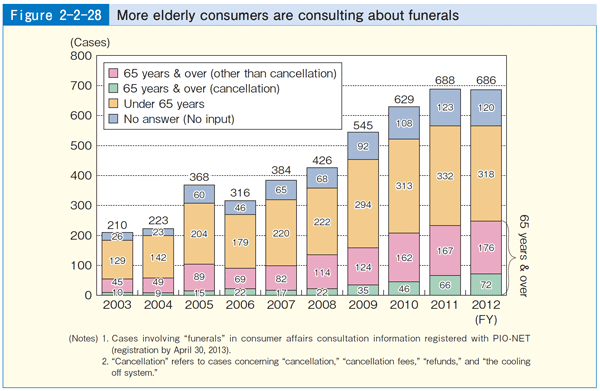Overview of consumer problems faced by the elderly
Part 1 : Today's consumer issues and consumers' behavior/attitude
Chapter 2 : [Feature] Consumer problems faced by the elderly
Section 2 : Overview of consumer problems faced by the elderly
The number of consumer affairs consultations for the elderly is growing faster than the elderly population
- The total number of consumer affairs consultations provided at local consumer affairs centers across Japan has been declining recently, with a 20.4% fall from the FY 2007 level recorded in FY 2012. The breakdown of the figure by the age group of consumers shows that consultations for those under 65 years old have followed a similar trend. However, consultations for the elderly indicated an opposite trend, increasing 34.7% in FY 2012 from the FY 2007 level, which translates into growth faster than the growth of elderly population.
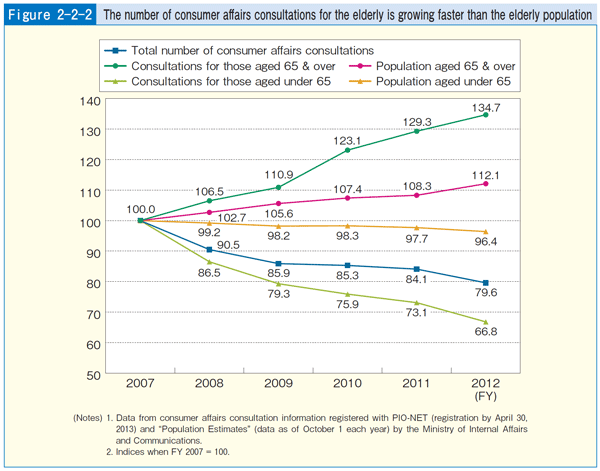
(Special note) PIO-NET
PIO-NET (Practical Living Information Online Network System) is a system to gather information on consumer life consultations offered to consumers by the local consumer affairs centers. It connects the National Consumer Affairs Center of Japan with local consumer affairs centers across Japan.
Elderly people were harmed most often by cosmetics (goods) and healthcare (service)
- Among FY 2012 consumer affairs consultations involving elderly people being harmed, "cosmetics" topped the list of goods that caused physical damage, and "healthcare" the list of services that caused physical damage.
- A phenomenon particular to the elderly is that nursing-care bed rails have continued to cause fatal and serious injury accidents over the past few years, with many cases leading to death.
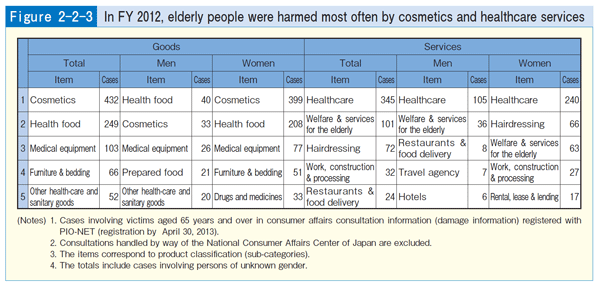
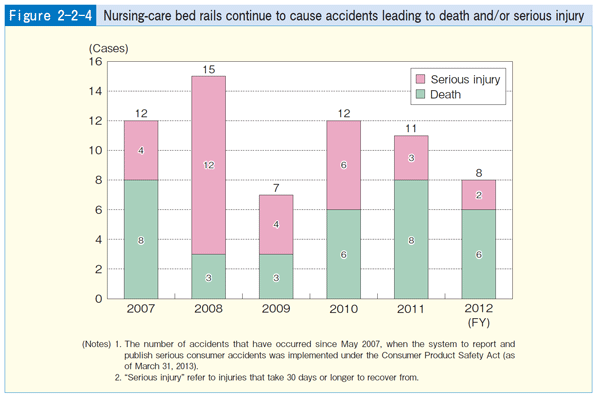
Telemarketing sales showed a notable increase as the source of problem for the elderly
- In FY 2003, 43.5% of consumer problems encountered by elderly people involved "door-to-door sales." The figure declined to 19.0% in FY 2012. In contrast, the proportion of "telemarketing sales" grew to 19.5% in FY 2012 from 8.0% in FY 2003.
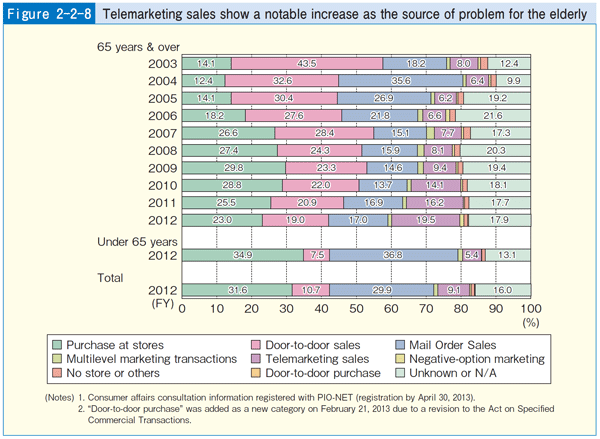
Elderly people's consumer consultation cases involved an increasing amount of money on average
- The average contract/purchase value reported in complaints from elderly people was approximately 2円.10 million in FY 2012, almost double the amount in FY 2003 (approximately 1円.06 million). The average amount paid followed a similar trend, showing that payments made by elderly consumers involved in problems has been increasing in the medium to long term.
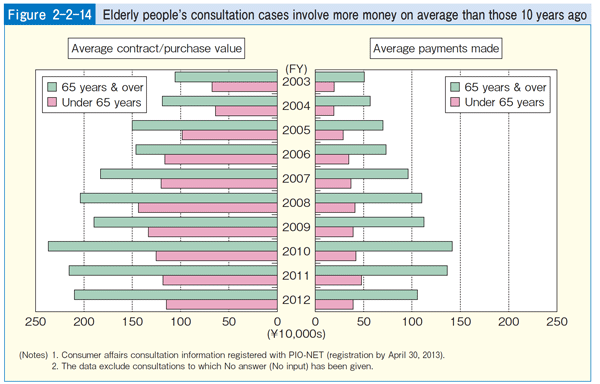
Financial products reported by elderly consumers concentrated on specific items for specific periods
- Investment products have been the leading cause of consumer problems faced by elderly people recently. Consultations on "derivatives" peaked in the July-September period of 2010; those on "prelisted shares" in the January-March period of 2011; those on "corporate bonds (contracts with non-financial institutions)" in the July-September period the same year; and those on "fund-type investment products" in the October-December period the same year. Apparently, different products emerge and spread one after another.
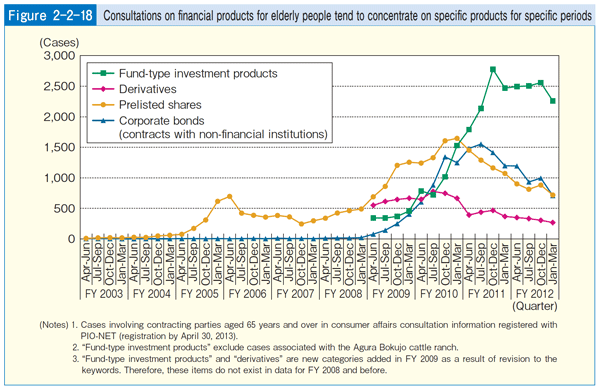
More elderly consumers were subjected to "secondary damage"
- "Secondary damage" refers to damage from fraudulent schemes targeting victims of past consumer frauds. These victims are approached by people who pretend to help them solve problems with previously contracted products/services, saying, "we can cancel them for you," or "we will recover your losses," and eventually get swindled. The number of consultations on such schemes had been declining until FY 2009, but increased thereafter, reaching almost 19,000 cases in FY 2011 and nearly 16,000 cases in FY 2012.
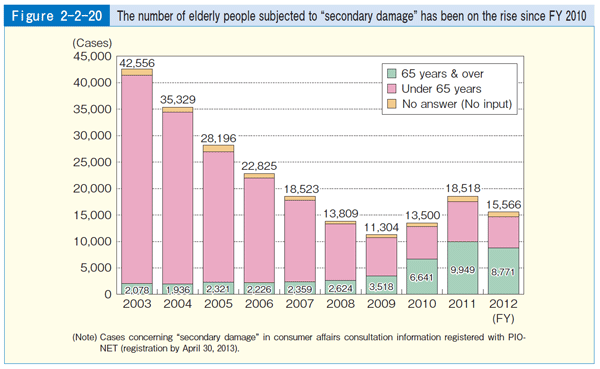
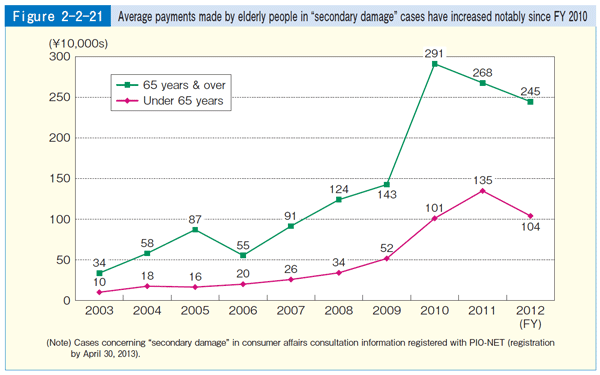
Problems involving negative-option marketing of health food have soared
- The number of consultations for the elderly on the negative-option marketing of health foods sharply increased in FY 2012. As a result, consultations on such issues totaled almost 14,000 cases in the year, of which elderly people accounted for about 80%.
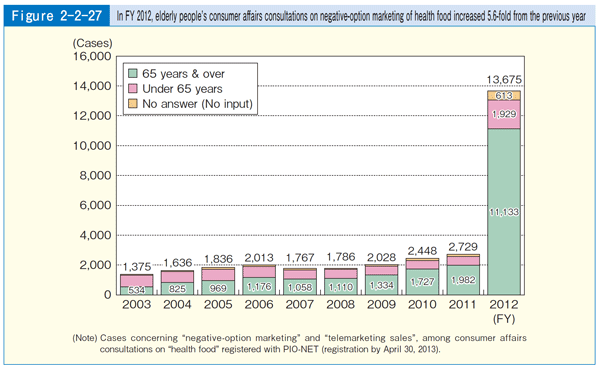
Consumer problems associated with so-called "shukatsu" are expected to increase further
- As families become smaller, a greater number of elderly people are engaged in so-called "shukatsu" (activities toward the end of life), in which they prepare for death by making necessary arrangements, such as the funeral, grave and inheritance, while they are alive. This has resulted in associated consumer problems. For example, the number of consultations on funerals has been rising over these years, reaching almost 700 cases in FY 2012.
